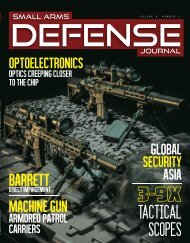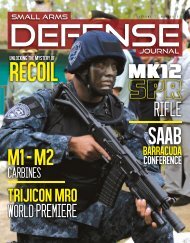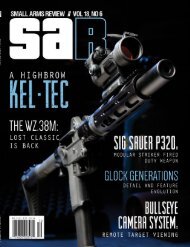You also want an ePaper? Increase the reach of your titles
YUMPU automatically turns print PDFs into web optimized ePapers that Google loves.
firearms, combined with the inability to secure<br />
a law enforcement sign off has created<br />
a market for pistols based upon full sized<br />
rifles. Examples include the SIG 556 pistol,<br />
a .223 caliber pistol based upon the SIG<br />
556 rifle, or any number of AK-type pistols,<br />
based upon the design of the semiautomatic<br />
AK-47 rifle. Such pistols were not available,<br />
and were barely conceivable in 1985. Substitution<br />
of the law enforcement sign off requirement<br />
for the NICS program may have<br />
helped alleviate some of the current issues<br />
with NFA look-alike firearms, but ultimately,<br />
these types of pistols were likely to come to<br />
market eventually.<br />
When both issues are combined, the<br />
issue over AP ammunition and enforcement<br />
of the law becomes relevant. According to<br />
ATF, the correct framework under which to<br />
examine the legality of M855 ammunition<br />
is the LEOPA and the regulatory intent of<br />
the legislation – namely, the safety of law<br />
enforcement officers and application of the<br />
sporting purposes test. ATF asserts that the<br />
only means of examining the M855 round<br />
is to determine whether a pistol fires the<br />
M855 round, and whether the M855 round<br />
meets the requirements of AP ammunition<br />
as described in 18 U.S.C. 921 (a)(17). If both<br />
conditions are met, by definition, the M855<br />
round is armor piercing. The U.S. Attorney<br />
General may then choose whether to exempt<br />
the M855 under the sporting purposes test.<br />
ATF TAKES A TUMBLE.<br />
Laws are made by Congress. Interpretation<br />
is assigned to the agencies that govern<br />
that subject matter. As a result, discharge<br />
from a smokestack would be governed by the<br />
Environmental Protection Agency (EPA). The<br />
EPA would be tasked with creating rules and<br />
regulations necessary to enforce laws created<br />
by Congress. The same applies to firearms.<br />
Congress passed the GCA and LEOPA. ATF<br />
in turn creates rules and regulations needed<br />
to interpret and enforce the law. As one might<br />
guess, interpretation and enforcement is political,<br />
and may (or may not) conform to societal<br />
norms or industry expectations.<br />
Rulemaking is also governed by law.<br />
Federal agencies are required to follow the<br />
Administrative Procedure Act, a law that<br />
dictates how rules and regulations are made.<br />
In general, the agency makes an announcement<br />
of a proposed rule, calls for comments<br />
from the public, reviews and responds to<br />
the comments made, and announces the<br />
final rule. This process can take several<br />
months or more. Changes to existing rules<br />
call for the same type of prior notice and<br />
comment period.<br />
On February 13, 2015, ATF published<br />
the 2014 ATF Regulation Guide. The prior<br />
guide was published in 2005, making<br />
the newly updated guide relevant and<br />
necessary. Within the guide, ATF omitted the<br />
current AP exemption for M855 ammunition<br />
from the regulations.<br />
On February 14, one day after publishing<br />
the 2014 regulatory guide, ATF called for<br />
comments to revoke the current exemption in<br />
place for M855 ammunition. Within the call<br />
for comments, ATF specifically calls for a determination<br />
of whether certain projectiles are<br />
“primarily intended for sporting purposes”<br />
within the meaning of 18 U.S.C. 921 (a)(17)<br />
(c) – invoking both the LEOPA and the GCA<br />
as the basis for the proposed rule change.<br />
Comments were to be accepted through<br />
March 16, 2015.<br />
On the face of the call for comments, the<br />
rule change appeared neutral. Nevertheless,<br />
ATF has consistently interpreted “sporting<br />
purposes” to only include the traditional<br />
sporting uses for firearms – namely, hunting,<br />
competitive target shooting, and skeet<br />
and trap shooting. ATF’s historical interpretation<br />
of the sporting purposes test does not<br />
include plinking or practical shooting, which<br />
ATF has ruled to be police or combat-style<br />
competition, and not “sport.” M855 ammunition<br />
can be used in hunting, but its use is<br />
limited. Although neutral on its face, and in<br />
conjunction with the totality of ATF’s actions,<br />
the call for comments was likely a precursor<br />
to a rule change revoking the exempt status<br />
of M855 ammunition.<br />
On March 6, ATF attempted to calm<br />
public fears and outrage through Twitter<br />
by tweeting, “Nothing to analyze here folks,<br />
just a publishing mistake. No AP ammo<br />
exemptions revoked.”<br />
On March 10, ATF published a special<br />
advisory, noting that more than 80,000<br />
comments had already been received.<br />
ATF also noted:<br />
“Although ATF endeavored to create a<br />
proposal that reflected a good faith interpretation<br />
of the law and balanced the interests<br />
of law enforcement, industry, and sportsmen,<br />
the vast majority of the comments received<br />
to date are critical of the framework,<br />
and include issues that deserve further study.<br />
Accordingly, ATF will not at this time seek<br />
to issue a final framework. After the close of<br />
the comment period, ATF will process the<br />
comments received, further evaluate the issues<br />
raised therein, and provide additional<br />
open and transparent process (for example,<br />
through additional proposals and opportunities<br />
for comment) before proceeding with any<br />
framework.” (Emphasis added.)<br />
By the close of the comment period on<br />
March 16, a reported 300,000 comments had<br />
been received by ATF, the majority of comments<br />
against the proposed ATF rule change.<br />
On March 10, ATF also published a<br />
Notice of Publishing Error, noting that the<br />
2014 ATF Regulation Guide omitted the AP<br />
exemption for M855 ammunition, but that<br />
“ATF has not rescinded any armor piercing<br />
ammunition exemption, and the fact they are<br />
not listed in the 2014 online edition of the<br />
regulations was an error which has no legal<br />
impact on the validity of the exemptions.”<br />
ATF asserts that the oversight will be corrected<br />
in the near future, and the exemption added<br />
to the 2014 regulatory guide.<br />
On March 12, in testimony before the<br />
U.S. Senate Appropriations Subcommittee<br />
on Commerce, Justice and Science, ATF Director<br />
B. Todd Jones said that ATF would not<br />
act on more than 30 requests (some pending<br />
for more than three years) for sporting use<br />
exemptions (i.e., an AP exemption) sought by<br />
ammunition makers for non-traditional ammunition<br />
designs without a new regulatory<br />
framework in place. ATF has acknowledged<br />
these petitions are for the hunting market,<br />
which they regard as a “traditional sport.” In<br />
theory, exemptions for the pending exemption<br />
request should be granted quickly and<br />
easily through the sporting purposes test.<br />
Finally, on March 20, ATF Director B.<br />
Todd Jones announced his resignation, nine<br />
months after being confirmed to the position<br />
by Congress. Although Jones announced<br />
that he would be taking a position with the<br />
National Football League, the timing and<br />
extremely short tenure as Director speaks<br />
volumes about a political agenda and the<br />
Director’s failings.<br />
THE FUTURE<br />
It is important to note that ATF has not<br />
abandoned its efforts to re-classify M855 ammunition.<br />
Within the March 10 announcement,<br />
the agency states that “ATF will process<br />
the comments received, further evaluate the<br />
issues raised therein, and provide additional<br />
open and transparent process… before proceeding<br />
with any framework.” Curiously, was<br />
ATF referring to the 2014 regulatory guide<br />
omission when it was referring to providing<br />
an open and transparent process? By law,<br />
ATF is required by the APA to publish a draft<br />
of the proposed rule change and allow a comment<br />
period. Any efforts by ATF in the future<br />
should require public disclosure and input,<br />
but given the political nature of the agency,<br />
awareness and vigilance will be required.<br />
The preceding article is not intended<br />
as legal advice, and should not be taken as<br />
legal advice. If the reader has specific legal<br />
questions, seek competent legal counsel.<br />
Mr. Wong is a Washington licensed<br />
attorney. He regularly provides legal counsel<br />
to the firearm and defense industry via<br />
his law firm, The Firearms Law Group. Mr.<br />
Wong also maintains Hurricane Butterfly,<br />
an import/export company that assists U.S.<br />
firearm manufacturers and foreign buyers<br />
wade through the regulatory quagmire of<br />
U.S. import/export regulations. He may be<br />
found online at FirearmsLawGroup.com.<br />
SADEFENSEJOURNAL.COM 17









